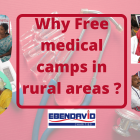Category Archives: Healthcare Support
Free Medical Camp in Rural Areas
Free Medical Camp in Rural Areas
A free medical camp is a life-saving program with a motive to provide free clinical and medical treatment for people from underprivileged backgrounds by a mobile team with varieties of medical specialized services.
Health Infrastructure in Rural Areas to conduct Free Medical Camp
A healthy individual contributes to the maximum overall development and growth of a country. A developed health infrastructure also guarantees a country of strong and healthy manpower for the production of goods and services.
Health infrastructure includes advanced machines, specialist doctors, nurses, and other paramedical professionals and developed pharmaceutical industries.
What is Good Health?
Generally, it is difficult to describe exactly what good health means. However, few scholars evaluate good health by taking various signs like an infant and maternal mortality rate, nutrition level, life expectancy, and with the current data of communicable and non-communicable diseases.
Medical infrastructure in India
Healthcare has become one of India’s largest sectors, both in terms of revenue and employment. Healthcare comprises hospitals, medical devices, clinical trials, outsourcing, telemedicine, medical tourism, health insurance, and medical equipment.
The Indian healthcare sector is growing at a brisk pace due to its strengthening coverage, services, and increasing expenditure by public as well private players. Indian healthcare delivery system is categorized into two major components public and private.
The Government, i.e. public healthcare system, comprises limited secondary and tertiary care institutions in key cities and focuses on providing basic healthcare facilities in the form of primary healthcare centers (PHCs) in rural areas.
The private sector provides the majority of secondary, tertiary, and quaternary care institutions with a major concentration in metros and tier I and tier-II cities. India’s competitive advantage lies in its large pool of well-trained medical professionals.
Health Care infrastructure in Tamilnadu
The health care infrastructure in rural areas has been developed as a three-tier system as follows.
- Sub-center
- Primary Health Centre (PHC)
- Community Health Centre (CHC)
As the coronavirus pandemic spreads its footprint across India, the rural health infrastructure is increasingly coming under scrutiny in the backdrop of the largest internal migration of modern times.
Coronavirus started gradually expanding to rural areas soon after India declared the presence of covid-19 in the country in January. The situation has been exacerbated with the reverse migration and a shortfall of healthcare services and doctors in rural areas.
Medical infrastructure companies in India
The Healthcare industry in India comprises hospitals, medical devices, clinical trials, outsourcing, telemedicine, medical tourism, health insurance, and medical equipment. The industry is growing at a tremendous pace owing to its strengthening coverage, services, and increasing expenditure by public as well as private players.
Growing incidence of lifestyle diseases, rising demand for affordable healthcare delivery systems due to the increasing healthcare costs, technological advancements, the emergence of telemedicine, rapid health insurance penetration, and government initiatives like e-health together with tax benefits and incentives are driving the healthcare market in India.
India is a land full of opportunities for players in the medical devices industry. The country has also become one of the leading destinations for high-end diagnostic services with tremendous capital investment for advanced diagnostic facilities, thus catering to a greater proportion of the population.
Besides, Indian medical service consumers have become more conscious of their healthcare upkeep. The Indian healthcare sector is much diversified and is full of opportunities in every segment, which includes providers, payers, and medical technology.
With the increase in the competition, businesses are looking to explore the latest dynamics and trends which will have a positive impact on their business. The hospital industry in India is forecast to increase to Rs. 8.6 trillion (US$ 132.84 billion) by FY22 from Rs. 4 trillion (US$ 61.79 billion) in FY17 at a CAGR of 16–17%.
The Government of India is planning to increase public health spending to 2.5% of the country’s GDP by 2025. India’s competitive advantage also lies in the increased success rate of Indian companies in getting Abbreviated New Drug Application (ANDA) approvals.
India also offers vast opportunities in R&D as well as medical tourism. To sum up, there are vast opportunities for investment in healthcare infrastructure in both urban and rural India.
Medical camps through Ebendavid Charities
Medical camps conducted by Ebendavid Charities provide free medical advice, medicine to the unfortunate people and refer them for specialized treatment or surgery whenever it is required. These camps make sure people are getting healthcare at the right time, and seeing the doctor early enough before a small health problem turns serious.
We join hands with various medical institutions and medical professionals driven by strong ethics of medicine who believe that it is the moral responsibility and obligation to treat each patient regardless of their income, race, or social status.
The main objective of our medical camp is to provide initial care to people in life-threatening conditions which reflects the unique strengths and goals of medical ethics. Other objectives are as stated below:
-Provide free and high-quality medical services for the poor population.
-Raise health awareness among the community and teach them to deal with communicable and no communicable.
-Register rare and severe cases and refer them to specialized centers.
–Evaluate the living conditions and determine the obstacles and challenges to work on solving their problems.
-Refer medical cases towards surgeries if required.
Medical Assistance is a program that has been started where free medicines have been provided and follow-ups to very sick patients, poor people who otherwise could not afford medical care. We have already supported 205 patients under this program.












